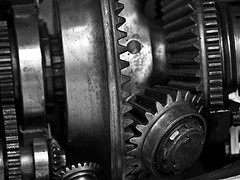 In the industrial world, gears are the primary source of operation for power transmission equipment. Different gears work in concert inside of a gearbox resulting in a precise output force that is specific to the application.
In the industrial world, gears are the primary source of operation for power transmission equipment. Different gears work in concert inside of a gearbox resulting in a precise output force that is specific to the application.
Here’s a look at what gears do and how they function together within a Falk gearbox.
What gears do. At its most basic, a gear is like a wheel, with teeth that are used to exert force on other gears. Power enters the gearbox through the input gear, which is typically attached to a motor, and is and sent out through the output gear to the specific piece of equipment being powered.
Gears can serve several different functions within a gearbox, such as converting speed into torque (known as gear reduction), changing the direction of rotation, and changing the axis of rotation.
Gear sizes in relation to power output. Gears of different sizes and different numbers of teeth operating together will result in a unique ratio of power and output shaft speed. The teeth of the gears act as levers on the shaft that the gear is mated to.
Gear size: The diameter of the gear affects how much of the leverage from the input gear is forced on the output gear.
Number of teeth: The number of teeth on the gear determines the ratio of rotational travel the teeth on the input gear will place on the output gear.
The gear ratio will affect the ratio between input and output shaft speed, which in turn will determine the revolutions per minute and torque that the power transmission transfers.
Gears in relation to power axis. Gears are also used to change the power axis between input and output forces. In other words, they can change the angle between the input and output of force. This allows the drive force to be located in a manner not in relation with the work equipment and is useful when space is at a premium. This is achieved when the input and output shaft angles intersect at a point, and the gears are beveled and angled in such a way to transfer power from one axis to another inside the gearbox.
Types of gears and gearboxes. The following are a few of the typical gears used in industrial power transmission equipment:
Parallel Shaft gearboxes. Power output is on the same axis as the input.
Bevel Helical. Non-parallel with the input and output axis crossing at some point.
Concentric. Power input and output are in line.
[Photo by: William Warby on Flickr via CC License]
Posted under Products/Services on Tuesday, March 15th, 2011
